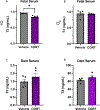Exogenous corticosterone administration during pregnancy in mice alters placental and fetal thyroid hormone availability in females
- PMID: 37579594
- PMCID: PMC10763606
- DOI: 10.1016/j.placenta.2023.08.005
Exogenous corticosterone administration during pregnancy in mice alters placental and fetal thyroid hormone availability in females
Abstract
Introduction: Maternal prenatal psychological stress is associated with adverse pregnancy outcomes and increased risk of adverse health outcomes in children. While the molecular mechanisms that govern these associations has not been fully teased apart, stress-induced changes in placental function can drive sex-specific phenotypes in offspring. We sought to identify and examine molecular pathways in the placenta that are altered in response to maternal prenatal stress.
Methods: We previously employed a mouse model of maternal prenatal stress where pregnant dams were treated with stress hormone (CORT) beginning in mid-gestation. Using this model, we conducted RNAseq analysis of whole placenta at E18.5. We used qRT-PCR to validate gene expression changes in the placenta and in a trophoblast cell line. ELISAs were used to measure the abundance of thyroid hormones in maternal and fetal serum and in the placenta.
Results: Dio2 was amongst the top differentially expressed genes in response to exogenous stress hormone. Dio2 expression was more downregulated in placenta of female fetuses from CORT-treated dams than both control placenta from females and placenta from male fetuses. Consistent with Dio2's role in production of bioactive thyroid hormone (T3), we found that there was a reduction of T3 in placenta and serum of female embryos from CORT-treated dams at E18.5. Both T3 and T4 were reduced in the fetal compartment of the placenta of female fetuses from CORT-treated dams at E16.5. Exogenous stress hormone induced reduction in thyroid hormone in females was independent of circulating levels of TH in the dams.
Discussion: The placental thyroid hormone synthesis pathway may be a target of elevated maternal stress hormone and modulate fetal programming of health and disease of offspring in a sex-specific fashion.
Keywords: Placenta; Prenatal stress; RNA-Seq; Sex-specific; Thyroid hormone.
Copyright © 2023 Elsevier Ltd. All rights reserved.
Conflict of interest statement
Declaration of competing interest The authors declare that they have no known competing financial interests or personal relationships that could have appeared to influence the work reported in this paper.
Figures






Update of
-
Exogenous corticosterone administration during pregnancy alters placental and fetal thyroid hormone availability in females.bioRxiv [Preprint]. 2023 Aug 10:2023.07.05.547278. doi: 10.1101/2023.07.05.547278. bioRxiv. 2023. Update in: Placenta. 2023 Oct;142:1-11. doi: 10.1016/j.placenta.2023.08.005. PMID: 37461599 Free PMC article. Updated. Preprint.
Similar articles
-
Exogenous corticosterone administration during pregnancy alters placental and fetal thyroid hormone availability in females.bioRxiv [Preprint]. 2023 Aug 10:2023.07.05.547278. doi: 10.1101/2023.07.05.547278. bioRxiv. 2023. Update in: Placenta. 2023 Oct;142:1-11. doi: 10.1016/j.placenta.2023.08.005. PMID: 37461599 Free PMC article. Updated. Preprint.
-
Maternal Administration of the CNS-Selective Sobetirome Prodrug Sob-AM2 Exerts Thyromimetic Effects in Murine MCT8-Deficient Fetuses.Thyroid. 2023 May;33(5):632-640. doi: 10.1089/thy.2022.0612. Epub 2023 Mar 17. Thyroid. 2023. PMID: 36792926 Free PMC article.
-
Maternal corticosterone in the mouse alters oxidative stress markers, antioxidant function and mitochondrial content in placentas of female fetuses.J Physiol. 2019 Jun;597(12):3053-3067. doi: 10.1113/JP277815. Epub 2019 May 20. J Physiol. 2019. PMID: 31026055
-
[Transfer and metabolism of thyroid gland hormones in the placenta].Acta Med Austriaca. 1997;24(4):138-43. Acta Med Austriaca. 1997. PMID: 9441548 Review. German.
-
The role of the placenta in thyroid hormone delivery to the fetus.Nat Clin Pract Endocrinol Metab. 2009 Jan;5(1):45-54. doi: 10.1038/ncpendmet1026. Nat Clin Pract Endocrinol Metab. 2009. PMID: 19079273 Review.
Cited by
-
Thyroid-stimulating hormone and total bile acids can predict adverse pregnancy outcome among patients with gestational hypertension.Am J Transl Res. 2024 Apr 15;16(4):1199-1208. doi: 10.62347/POGR1624. eCollection 2024. Am J Transl Res. 2024. PMID: 38715823 Free PMC article.
-
Sex-specific role of epigenetic modification of a leptin upstream enhancer in adipose tissue.Clin Epigenetics. 2025 Feb 11;17(1):21. doi: 10.1186/s13148-025-01830-2. Clin Epigenetics. 2025. PMID: 39934931 Free PMC article.
References
-
- Mulder EJ, Robles de Medina PG, Huizink AC, Van den Bergh BR, Buitelaar JK, Visser GH, Prenatal maternal stress: effects on pregnancy and the (unborn) child, Early Hum Dev 70(1–2) (2002) 3–14. - PubMed
-
- Rondo PH, Ferreira RF, Nogueira F, Ribeiro MC, Lobert H, Artes R, Maternal psychological stress and distress as predictors of low birth weight, prematurity and intrauterine growth retardation, Eur J Clin Nutr 57(2) (2003) 266–72. - PubMed
-
- Staneva A, Bogossian F, Pritchard M, Wittkowski A, The effects of maternal depression, anxiety, and perceived stress during pregnancy on preterm birth: A systematic review, Women Birth 28(3) (2015) 179–93. - PubMed
-
- Aufdenblatten M, Baumann M, Raio L, Dick B, Frey BM, Schneider H, Surbek D, Hocher B, Mohaupt MG, Prematurity is related to high placental cortisol in preeclampsia, Pediatr Res 65(2) (2009) 198–202. - PubMed
Publication types
MeSH terms
Substances
Grants and funding
LinkOut - more resources
Full Text Sources

